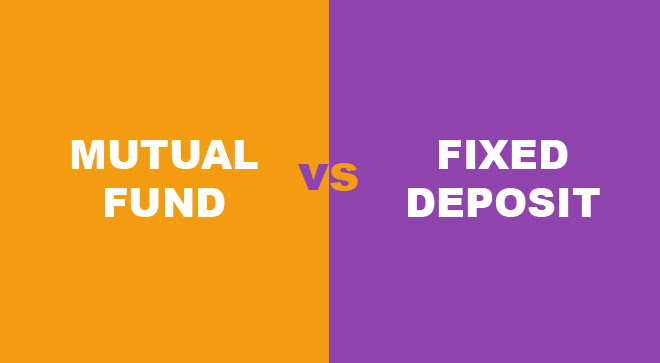Fixed deposits continue to be the most popular asset class with investors, because of the security they offer. Currently, most FD providers offer an interest rate of 6%–7%, with some financial institutions offering up to 8.1%. At present, a one-year fixed deposit earns a return of 6.25% on your investment.
An arbitrage fund is an equity-based mutual fund that leverages the price difference in the cash and derivatives market to earn returns for you. These funds may be less risky compared to equity, but don’t guarantee returns either. So before choosing any one you should be compare the Fixed deposit and mutual fund investment.

Take a look at 5 things that will help you choose which of the two is best for you.
Arbitrage funds work towards exploiting the variation in the price of a stock between the cash and derivative markets, or between equity listed in BSE and NSE. Let’s assume that the price of a stock is quoted at Rs.50 per unit in the cash market, while the price for the same stock in the future’s market is Rs.51.
Now, the fund will buy the stock in cash market to fulfil the demand in the futures market. This way, your investment remains safe and earns returns at the same time.
Arbitrage funds operate in volatile markets and capitalise on differences in prices of various securities. When the market conditions are not ideal for gains from arbitrage, the money goes into short-term debt funds and/or liquid investments. This helps the instrument ensure earnings for you. This is why arbitrage funds have earned a reputation for being safer than conventional equity investments.
Arbitrage funds are categorised as equity-based investments from a taxation perspective. Therefore, you don’t have to pay any tax on long-term gains. Long-term gains are gains made by holding an equity fund for more than one year. For short-term gains, which are made within a year, you would pay a flat rate of 15% as tax. In case of fixed deposits, you can claim up to Rs.10,000 as a deduction. Your earnings beyond this amount, are taxable.
Over the past few years, there has been excitement about arbitrage funds because of the returns they offer. But, remember that they are high-risk, as they do not offer a fixed return. On the other hand, they are a good choice if you are looking to invest with the aim of beating inflation. So, only opt for them when a strong risk appetite backs your interest for a high-yield investment.
There is no doubt that fixed deposit investments are the safest investment option. But, given the prevailing rates, you must take measures to ensure that you get the best interest rate possible to make fixed deposits (FD) a viable investment option. If you are looking for the best interest earnings on fixed deposit investment, invest with Bajaj Finance. They offer higher returns on fixed deposits with added flexibility of tenor and the investment amount.

Arbitrage mutual funds are more secure than a pure equity investment as they make short-term gains from price distortions. But, if safety is your ultimate goal, short-term fixed deposits are the ideal choice. They are also an ideal way to facilitate capital formation, especially for early-stage investors.
With NBFCs also accepting fixed deposits and offering better interest rates than traditional banks, research your options and find the ideal financial institution to secure your savings.
When evaluating company fixed deposits (FDs), it’s crucial to analyze the creditworthiness of the issuing institution. A high-rated corporate FD usually offers attractive interest rates, but if the company’s financial health deteriorates, investors may face a higher risk of default compared to an arbitrage mutual fund, which invests primarily in lower-risk instruments like government securities and high-quality corporate debt. Conduct a thorough review of credit ratings from reputable agencies and consider factors such as the company’s debt-to-equity ratio, existing liabilities, and track record of meeting obligations on time. In contrast, arbitrage funds have limited credit risk because they predominantly engage in buy-sell strategies on the same equity security, capturing short-term price differentials without taking significant directional risk in the market.
By juxtaposing these risk profiles, readers can decide if the potentially higher yield of a corporate FD justifies the added credit exposure compared to the relatively conservative nature of arbitrage mutual funds. For investors exploring options outside FDs and arbitrage funds, it may help to know where to find high risk personal loans for alternative high-yield strategies.
Tax efficiency can significantly impact the net returns of any investment. For company FDs, interest income is fully taxable at your applicable slab rate, and there is no benefit of indexation. In contrast, arbitrage funds qualify as equity-oriented funds if more than 65% of their portfolio is invested in equities; thus, short-term capital gains (holding period less than one year) are taxed at 15%, and long-term capital gains (holding period exceeding one year) are taxed at 10% on gains above ₹1 lakh per financial year, without indexation. This tax advantage often makes arbitrage funds more appealing for investors in higher tax brackets, as the effective after-tax yield can exceed that of a corporate FD with a comparable headline rate.
Always calculate your post-tax returns by factoring in your expected holding period and marginal tax rate. If you are navigating tight cash flows and need immediate credit-backed solutions, consider options like a $1,000 quick loan no credit check to manage liquidity without hampering long-term investments.
One of the major differentiators between company FDs and arbitrage mutual funds is liquidity. Company FDs often come with a lock-in period or penalty for premature withdrawal, which means you might incur a reduced interest rate or penalty charges if you need to exit early. Conversely, arbitrage mutual funds offer near-instant liquidity since you can redeem units on any business day, with funds typically credited within one to two business days. This flexibility can be particularly valuable if you anticipate sudden cash needs or want to rebalance your portfolio in response to changing market dynamics.
Moreover, arbitrage funds let you set up systematic withdrawal plans (SWPs) to create a steady income stream, whereas FDs require manual renewal or reinvestment strategies. If you’re facing an unexpected shortfall, you may also explore rapid disbursal products such as a $500 cash advance no credit check online to bridge financial gaps without liquidating long-term holdings.
Company FDs generally offer a fixed rate of interest for the entire tenure, insulating you from short-term interest-rate fluctuations. However, if the Reserve Bank of India raises benchmark rates during your FD tenure, new FD issuances might offer higher yields, making your existing FD less attractive in comparison. On the other hand, arbitrage funds capitalize on price differences between cash and derivatives segments, which are indirectly influenced by underlying interest rates and equity market volatility. This can lead to modest but more dynamic returns in rising-rate environments and potentially limited downside during market corrections.
Investors should understand that while FDs lock in a specific yield, arbitrage funds adjust portfolio allocations daily, reflecting current market pricing and volatility. If you need quick access to capitalized returns without fixed-rate constraints, consider platforms such as small personal loans online for a short-term bridge while staying invested.
In an inflationary environment, nominal returns can be misleading. A company FD offering 7% per annum might look attractive on paper, but if inflation is at 6%, the real return is effectively just 1%. Arbitrage funds, although typically yielding 5–6% in stable markets, can sometimes outperform inflation because of their tactical positioning in derivatives and cash segments, which helps cushion against eroding purchasing power. Understanding real return—after inflation—is essential to ensure your investments preserve and grow your wealth in real terms.
For those concerned about inflation risk eroding guaranteed but fixed returns, it might be worth diversifying into inflation-linked instruments or exploring credit-based lending solutions like private money lenders for personal loans that may offer variable rates aligned with market conditions.
The ease of investment and user experience can make a significant difference in how quickly you can deploy capital. For company FDs, some platforms require physical documentation or lengthy verification processes, whereas many digital investment platforms allow you to open and manage FDs online with minimal paperwork. Arbitrage funds, sold through mutual fund apps or broker platforms, typically allow instant KYC verification, immediate fund transfers, and automated portfolio allocation. This seamless experience can be a deciding factor for investors who value speed and convenience over marginal differences in headline yields.
Evaluate factors such as customer support responsiveness, digital interface stability, and automated portfolio rebalancing features. Should you need a fast, no-credit-check lending option while navigating these platforms, you can review offerings like loans for bad credit online guaranteed approval as a backup for any immediate liquidity crunch.
Credit Risk Assessment of Company Fixed Deposits vs. Arbitrage Funds
Taxation Differences and After-Tax Returns
Liquidity and Exit Options
Interest Rate Sensitivity and Market Dynamics
Impact of Inflation and Real Return Considerations
Choosing the Right Financial Platform for Seamless Investment







Leave a Reply: